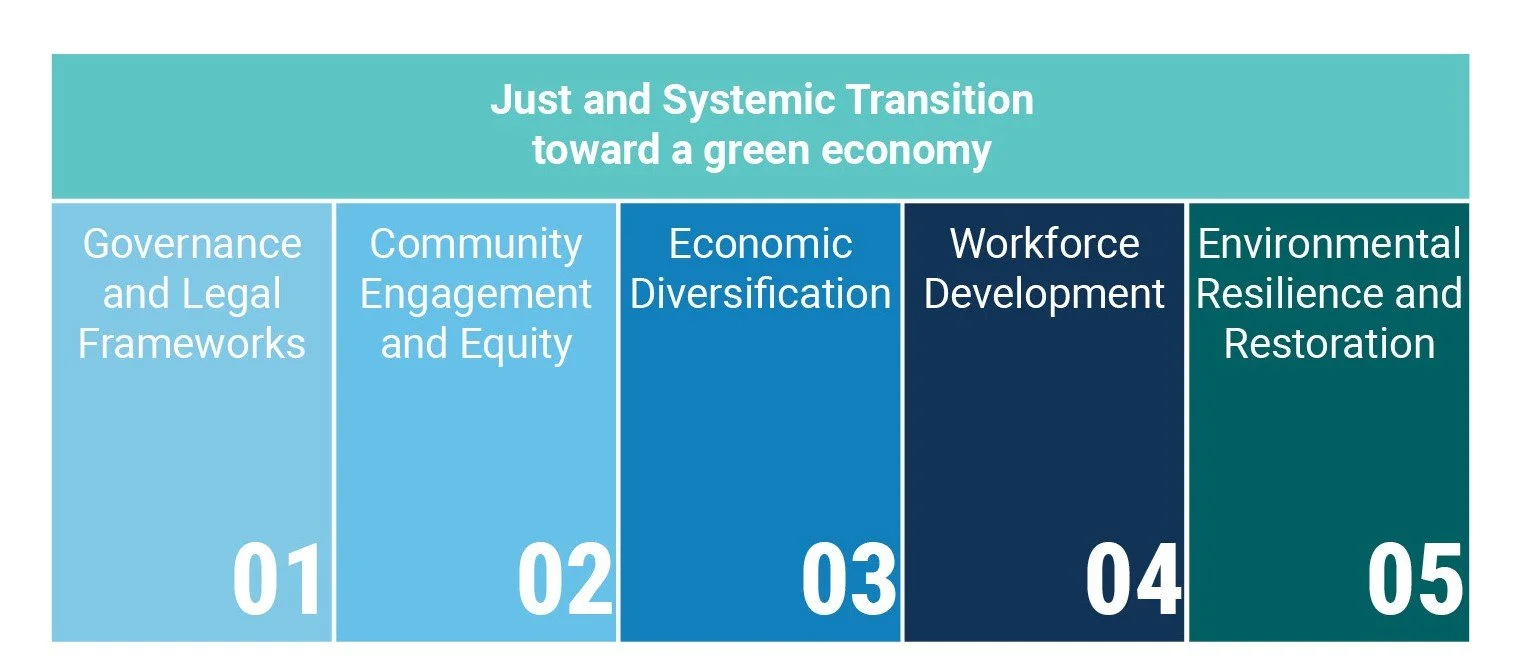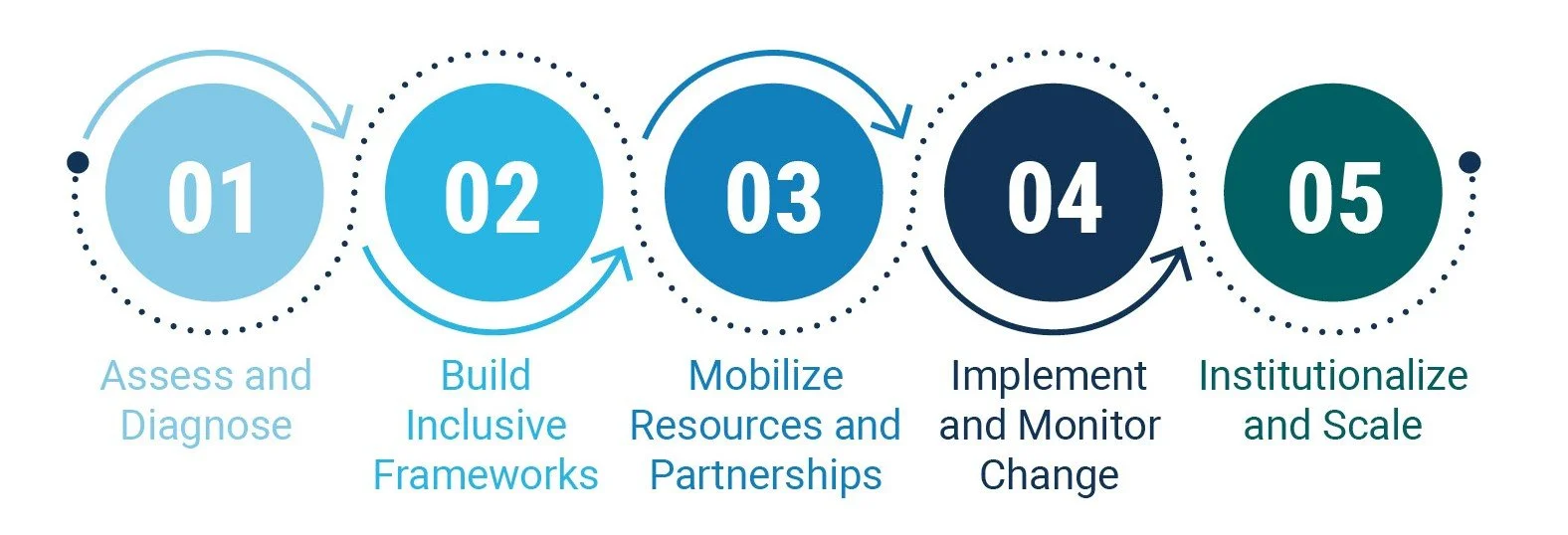Green Economy: Just Transitions in Fragile States – The Case of Ukraine
Green Economy: Just Transitions in Fragile States – The Case of Ukraine
In the face of intensifying climate crises and widening global inequalities, the concept of Just Transition (JT) has emerged as a transformative framework for steering the transition toward sustainable, inclusive economies. As defined by GIZ, a Just Transition ensures that "no one is left behind in the shift to a climate-neutral economy, emphasizing fair distribution of benefits, participatory processes, and support for workers and communities adversely affected." This approach is particularly critical in fragile and conflict-affected states, where vulnerabilities are heightened, and transitions must address not only environmental concerns but also systemic inequalities and institutional fragility.
Often associated with advanced economies and coal-dependent regions in Europe, Just Transition frameworks have demonstrated their utility in addressing socioeconomic disparities, entrenched corruption, and structural inequalities—challenges that resonate deeply in many emerging and fragile economies. For instance, the European Commission’s Just Transition Score provides a critical lens for evaluating countries’ readiness to transition equitably, incorporating indicators such as social welfare, environmental performance, and economic resilience. This tool underscores how fragile states can navigate recovery and reconstruction efforts through the principles of equity and sustainability, aligning short-term imperatives with long-term development goals.
Ukraine illustrates how crisis can drive transformation, tackling post-war recovery while future-proofing its economy. By applying Just Transition principles, the country addresses immediate needs while advancing sustainability. Beyond Group has supported this effort by developing change management strategies focused on equity, resilience, and participatory governance, offering a model for other fragile states. This highlights the green economy’s potential to reshape societies and promote equity.
Key Pillars of a Just and systemic Transition Framework for Fragile States
Just and systemic transitions in fragile states demand a comprehensive approach that addresses the unique challenges posed by conflict, economic instability, and limited institutional capacity. To achieve a Just and Systemic Transition toward a green economy in such contexts, five core pillars emerge as critical:
1. Governance and Legal Frameworks
Effective governance and legal frameworks are foundational for systemic transitions. In fragile states, this requires more than policy alignment; it entails fundamental legal reforms to enable sustainable economic shifts. Ukraine's alignment with the European Green Deal exemplifies how legal and policy measures can establish the groundwork for transition, even amidst adversity. Targeted legal reforms, such as incentives for renewable energy investment and green job creation, are particularly vital in regions lacking resources. For fragile states, streamlined and adaptable legal frameworks help mitigate risks, attract investment, and ensure regulatory stability, all of which are essential for fostering confidence in systemic transformation.
2. Community Engagement and Equity
Fragile states face acute challenges in ensuring community participation and equitable outcomes during systemic transitions. Marginalized groups, often disproportionately affected by conflict and environmental degradation, must be actively included in the decision-making process. In Ukraine’s coal-dependent regions, for instance, the social and economic costs of transitioning to renewable energy weigh heavily on local populations. Emphasizing procedural justice through transparent and participatory processes, such as public consultations, community workshops, and collaborative policy design, builds trust and ensures that transition efforts are inclusive. This is particularly critical in fragile states, where mistrust in institutions is often pervasive, and community buy-in is essential for success.
3. Economic Diversification
Economic diversification is a cornerstone of systemic transitions, offering pathways to reduce dependence on carbon-intensive industries while building economic resilience. For fragile states, this involves leveraging local strengths to develop sustainable industries. Ukraine’s aim to achieve 25% renewable energy in its electricity mix by 2035 highlights the potential of diversification efforts. However, these transitions often face barriers such as limited infrastructure, capital constraints, and bureaucratic hurdles. Fragile states can benefit from focusing on green industries that offer local job creation, such as eco-tourism, sustainable agriculture, and renewable energy manufacturing. By investing in these sectors, states not only reduce environmental impact but also provide tangible benefits to their economies and communities.
4. Workforce Development
A green economy transition requires a workforce equipped with relevant skills to thrive in new industries. Fragile states often face significant challenges in workforce development, from resource limitations to societal barriers like gender inequality and access to education. In Ukraine’s coal towns, for example, transitioning workers to green jobs demands targeted training programs and support structures. Mobile training units, scholarships for technical education, and inclusive vocational programs tailored to green industries are critical. These initiatives not only ensure that workers can adapt but also foster social inclusion by addressing disparities in access to opportunities.
5. Environmental Resilience and Restoration
Fragile states are frequently at the frontline of environmental degradation and climate vulnerability. Integrating environmental resilience and restoration as a key pillar ensures that systemic transitions account for the interconnected challenges of ecological preservation and human development. Initiatives such as reforestation, sustainable water management, and soil
restoration not only combat climate change but also create jobs and strengthen communities’ adaptive capacities. For instance, in conflict-affected regions of Ukraine, ecosystem restoration can serve as a tool for both reconciliation and economic revitalization, linking environmental goals with social cohesion and long-term recovery.
Challenges and Opportunities of a Just and Systemic Transition
The pathway to a Just Transition in fragile states is fraught with complexities, but it also offers transformative opportunities for growth and resilience. Drawing from the global case studies, three critical challenges and three compelling opportunities emerge as defining elements of this journey.
Challenges
Economic Disruption and Job Displacement
The closure of unprofitable industries can lead to significant economic upheaval and the loss of thousands of jobs. In fragile states, where alternative employment options are limited, such disruptions can exacerbate poverty and widen inequalities.
Weak Institutional Capacities
Many fragile states struggle with limited governance structures and public sector capacity, making it difficult to implement and monitor Just Transition policies effectively. Corruption and bureaucratic bottlenecks can further hinder progress, undermining trust and delaying much-needed interventions.
Risk of Social Unrest
The lack of adequate social safety nets and transparent decision-making processes can lead to discontent among affected populations. Communities that feel excluded or marginalized, particularly in conflict-affected regions, may resist transition efforts, leading to unrest and instability.
Opportunities
Economic Diversification and Innovation
The transition to renewable energy and sustainable industries provides a chance to diversify fragile economies. Expanding green sectors such as renewable energy production, eco-tourism, and sustainable agriculture could create new jobs and reduce reliance on high-carbon industries.
Community Empowerment and Equity
By prioritizing community engagement and procedural justice, fragile states can empower marginalized populations and foster inclusivity. Ukraine’s efforts to engage coal-dependent towns in designing change management roadmaps showcase how participatory processes can strengthen trust, ensure equitable outcomes, and reduce social tensions.
Environmental Restoration and Resilience
Fragile states often bear the brunt of environmental degradation. Just Transition initiatives that incorporate ecosystem restoration, such as reforestation and sustainable water management, offer dual benefits: mitigating climate risks and creating employment opportunities. For
example, programs that restore ecosystems in conflict-affected areas can serve as tools for reconciliation and economic revitalization.
A Roadmap for Just and Systemic Transitions
Transitioning fragile and conflict-affected states toward sustainable and equitable economies requires a structured approach that addresses unique challenges while leveraging opportunities for transformation:
1. Assess and Diagnose
The first step is conducting a comprehensive assessment of the socio-economic, environmental, and institutional landscape. This includes identifying vulnerable populations, understanding local economic dependencies, and mapping governance capacities
2. Build Inclusive Frameworks
Developing inclusive governance and policy frameworks ensures that the transition process is participatory and equitable. Fragile states must engage diverse stakeholders such as government, civil society, and local communities, to co-design policies that address systemic inequalities
3. Mobilize Resources and Partnerships
Securing financial resources and fostering international partnerships are crucial for addressing the resource gaps that fragile states often face. International donors, development organizations, and private sector investors must be aligned with Just Transition principles
4. Implement and Monitor Change
Transition initiatives must focus on practical, scalable solutions tailored to local realities. Workforce development programs, economic diversification efforts, and environmental restoration projects should be implemented with clear timelines and metrics for success.
5. Institutionalize and Scale
Finally, systemic transitions must be institutionalized to ensure long-term sustainability. This involves embedding Just Transition principles into national development plans, fostering local ownership, and scaling successful pilot projects to other regions.
The journey toward a Just Transition in fragile states is not only a response to pressing challenges but a chance to redefine development pathways. By embracing tailored strategies that prioritize equity, sustainability, and resilience, these states can transform vulnerabilities into opportunities for inclusive growth. As the global community deepens its commitment to climate action, the lessons emerging from fragile contexts will shape the next generation of policies and practices, paving the way for a more balanced and sustainable future.



